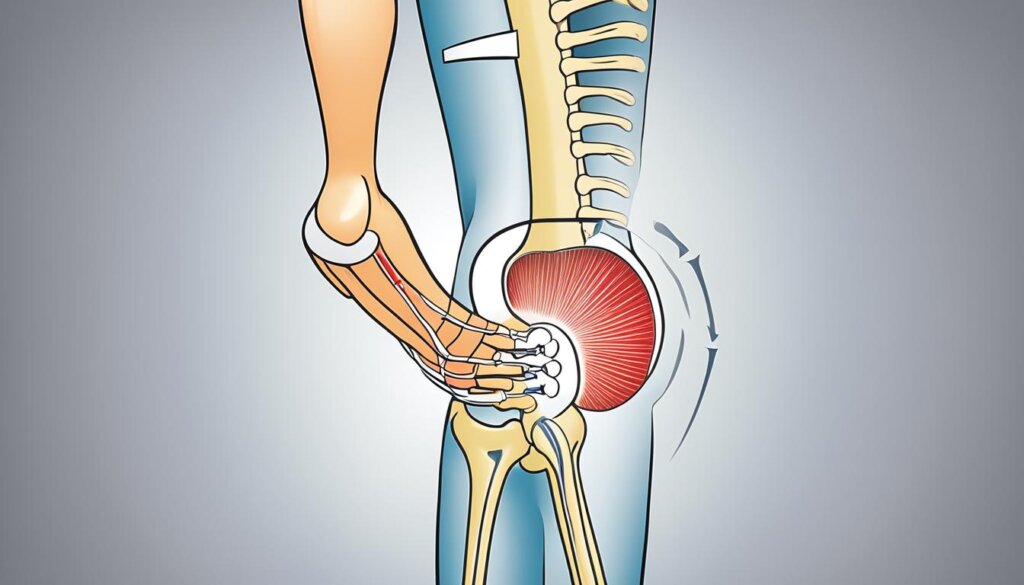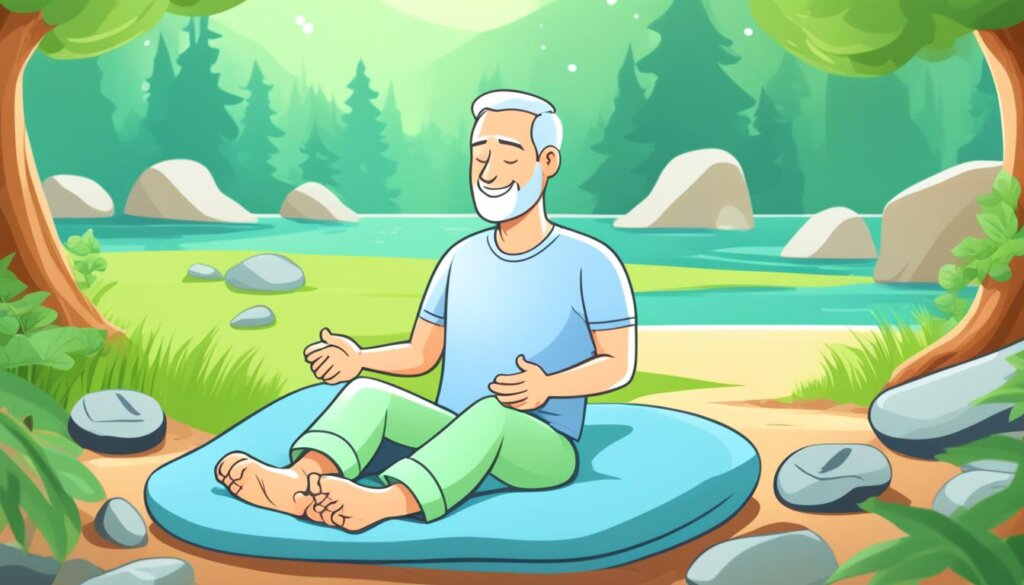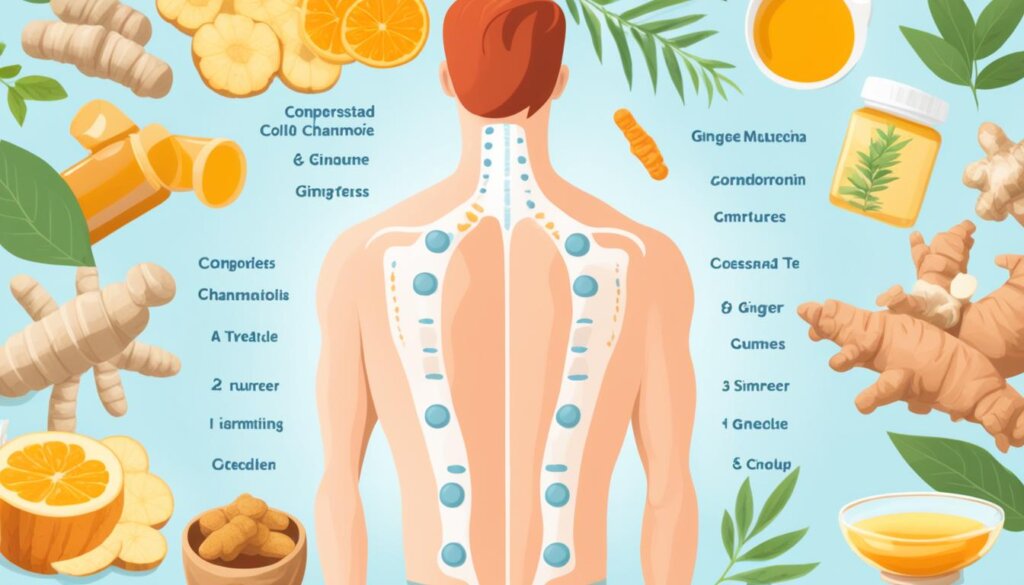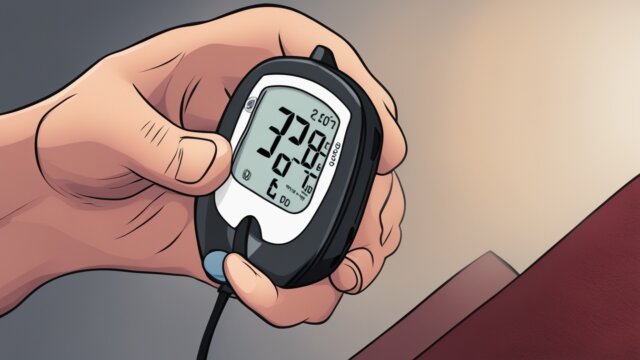FTC disclaimer: This post may contains affiliate links and we will be compensated if you click on a link and make a purchase.
Sciatica is a common pain in the lower back and legs. It affects nearly 40% of adults at some point. This pain can make daily activities hard and lower the quality of life. Luckily, there are many natural ways to help with this pain. This article will look at the best ways to ease sciatica pain at home.
Key Takeaways
- Sciatica pain affects a significant portion of the adult population, with far-reaching impacts on daily life.
- Conservative treatment methods like home remedies can alleviate sciatica pain in up to 80% of cases within 3 months.
- Exercises, posture correction, and supportive bedding can effectively manage and reduce sciatica symptoms.
- Over-the-counter medications and alternative therapies can provide immediate relief and long-term management of sciatica pain.
- Seeking medical attention is recommended if self-care remedies do not provide relief after a few days, as around 30% of cases require specialized treatment.
Understanding Sciatica Pain
Causes and Symptoms of Sciatica
Sciatica is not a condition but a symptom of other issues like a herniated disc or nerve compression. Common causes include a herniated disc, spinal stenosis, and piriformis syndrome. Symptoms include lower back pain, numbness, and weakness in the leg or foot.
Sciatica usually affects one leg but can happen in both in rare cases. It can start suddenly or slowly, based on the cause. Pregnancy hormones can make sciatica more likely, with relief found in physical therapy and warm showers.
Hip problems cause pain in the groin, not the sciatica pain that goes down the leg. Rest helps at first, but too much rest can make it worse. Sciatica can cause swelling in the leg due to various issues. Surgery is rare but can be needed for severe cases.

Doctors use tests like MRI scans to diagnose sciatica. CT scans and EMG help confirm nerve injuries.
Doctors use many medicines to treat sciatica. Physical therapy helps with pain and movement. Steroid injections and surgery are options for severe cases.
Self-care like cold packs and stretching helps with sciatica. Pain relievers and alternative therapies like acupuncture can also help. See a doctor if symptoms are serious or last over a month.
Importance of Immediate Relief for Sciatica Pain
Sciatica pain can really mess up your day. So, finding quick relief is key. It helps ease the pain, stops muscle spasms, cuts down on swelling, and keeps muscles strong. This way, you can get back to doing what you love faster.
Many people get sciatica, which is pain from the sciatic nerve. About 10% to 40% of people will get sciatica at some point, and 1% to 5% each year. Getting it treated fast is important to stop it from getting worse.
If sciatica isn’t treated, it can make muscles weak, limit how you move, and even harm nerves for good. So, it’s key to get help right away with self-care and doctor advice. This way, you can fix the problem and move on with your life.
Immediate Sciatica Pain Relief Strategies | Benefits |
|---|---|
Cold therapy within the first 2-3 days | Reduces inflammation and pain |
Heat therapy after the initial sharp pain subsides | Provides pain relief and relaxes muscles |
Over-the-counter pain medications | Helps manage pain and inflammation |
Gentle stretching and low-impact exercise | Improves mobility and muscle strength |
Acting fast to help your sciatica can bring quick relief and help you manage it better over time. Remember, acting quickly is crucial for sciatica, so don’t wait to get the right help and support.

Home Remedies for Sciatica
Sciatica is a common issue that causes pain down the back of the leg. You can manage it with home remedies. These natural ways to treat sciatica help without the side effects of drugs. Let’s look at some effective home treatments for sciatica that can give quick and lasting relief.
Pain Management with Hot and Cold Therapy
Using cold packs can lessen inflammation and dull the pain. Heat from a heating pad helps blood flow better, relaxes muscles, and takes pressure off the sciatic nerve. Switching between heat and ice can help sciatica pain right away, making blood flow better and aiding healing.
Over-the-counter medications for Sciatica
Over-the-counter drugs like NSAIDs can ease pain by lowering inflammation. NSAIDs such as Tylenol and Advil help sciatica patients by reducing swelling. Topical gels, creams, or patches can also give quick sciatica pain relief with fewer side effects than pills.
Home Remedy | Benefits |
|---|---|
Hot and Cold Therapy | Reduces inflammation, improves blood flow, and relaxes muscles |
OTC Medications | Provides prompt pain relief by reducing inflammation |
Topical Treatments | Offers fast and effective relief with lower risk of side effects |
By using these home remedies, people with sciatica can find relief and handle their symptoms without needing more serious treatments.

“Pain relief is essential for sciatica patients, and these home remedies provide a safe and natural way to manage their symptoms.”
Gentle Exercise and Stretches
Gentle exercises and sciatica stretches can ease muscle spasms and strengthen muscles around the spine. They also reduce pressure on the sciatic nerve. Stretches like the sitting pigeon pose and reclined pigeon pose help with sciatica pain.
Stretching for Sciatica Relief
For sciatica relief, focus on stretches that rotate the hip outward. Avoid bending, lifting, or twisting exercises that can make it worse. Try the seated glute stretch and seated spinal stretch for help.
Listen to your body and stop if you feel pain during stretches. Pregnant women can benefit from these gentle exercises too. Doing them at least twice a week is good.
Low-impact activities like swimming can ease sciatica pain. But, avoid high-impact activities like running on hard surfaces during recovery.
If sciatica pain lasts over a month, see a doctor for help. Getting the right treatment early can make a big difference.

Start with gentle exercises and listen to your body. Slowly increase the intensity as you get more comfortable. With the right steps, you can ease sciatica pain and prevent future episodes.
Improve and Correct Your Posture
Keeping the right posture while sitting and sleeping is key to easing sciatica pain. When sitting, pick a chair that supports your lower back. Make sure your feet are flat on the floor. For sleeping, choose a mattress that keeps your spine straight. Use pillows under your knees or between your legs for better alignment.
Good posture can stop and ease sciatica symptoms. Being mindful of your posture during everyday tasks, like sitting at a desk or driving, can help manage sciatica pain.
Proper Sitting Posture for Sciatica
- Sit up straight, with your shoulders back and your head aligned with your spine.
- Ensure your lower back is supported, either by using a lumbar pillow or adjusting the backrest of your chair.
- Keep your feet flat on the floor, with your knees at a 90-degree angle or slightly wider.
- Avoid crossing your legs, as this can put pressure on the sciatic nerve.
Sleeping Positions for Sciatica
- Sleep on your side with a pillow between your knees to keep your spine aligned.
- Use a pillow under your knees if you sleep on your back to maintain the natural curve of your spine.
- Avoid sleeping on your stomach, as this can twist your spine and make sciatica worse.
By keeping the right posture and using supportive sleeping positions, you can ease sciatica symptoms and prevent it from getting worse. Small changes in your daily life can make a big difference in managing this pain.
“Practicing good posture, core strength exercises, regular exercise, maintaining a moderate weight, and using proper lifting techniques can help prevent sciatica.”
Use Supportive Pillows and Mattresses
Getting quality sleep is key to managing sciatica pain. The right pillows and mattress can really help. It’s important to have the right firmness and support to lessen sciatic nerve pain.
A mattress that keeps your spine aligned and pillows that balance your hips and legs can improve sleep and lessen sciatica symptoms.
Sciatica-Friendly Mattresses should match your sleep position. For stomach sleepers, firmer mattresses are best. Medium-firm for back sleepers, and softer with extra support for side sleepers. A good mattress can greatly help with sciatica pain.
Pillows for Sciatica Relief can also help a lot. Using a body pillow or a regular pillow between your knees can align your spine and hips. Elevating your knees with a pillow can also ease pain and improve sleep.
Other Sleeping Aids for Sciatica include gentle stretches before bed, a warm bath to relax muscles, and not sleeping on your stomach. Adding these to your routine can make your sleep better and lessen sciatic nerve pain.
Finding the right support and comfort is key for managing sciatica at night. Try different Pillows for Sciatica Relief and Sciatica-Friendly Mattresses to see what works best for you. With the right aids, you can have more restful and pain-free nights, helping with your sciatica recovery.
Home Remedies for Sciatica
If you’re looking for natural ways to ease sciatica pain, there are many home remedies you can try. Sciatica happens when the sciatic nerve gets irritated, inflamed, pinched, or compressed. This can cause pain on one side of the buttocks and leg, sharp or stabbing feelings, tingling, numbness, and burning. Most of the time, sciatica gets better in 4-6 weeks. But sometimes it lasts longer, so trying home treatments can help a lot.
Using hot and cold therapy, like a heating pad or ice pack, can help. It reduces inflammation and relaxes muscles. You can also use over-the-counter medicines like ibuprofen, naproxen, and acetaminophen to ease pain and swelling. Massage can help relax tight muscles and take pressure off the sciatic nerve.
Doing gentle exercises and stretches can also help. Try the Standing Hamstring Stretch, Sitting Pigeon Pose, and Reclining Pigeon Pose. These stretches stretch muscles and ease pressure on the sciatic nerve. Low-impact activities like walking and swimming can also help by strengthening muscles and releasing endorphins to manage pain.
Keeping a good posture and using supportive pillows and mattresses can also help with sciatica. If your pain lasts about a month, you should see a back specialist. They can give you more advanced treatment if needed.
Remember, while these home remedies can help, it’s best to talk to a healthcare professional before starting new treatments. Some conditions like spinal stenosis, injury, and others might need special care to manage sciatica pain.
By using a mix of these Sciatica Home Treatments, Natural Sciatica Relief, and DIY Sciatica Remedies, you can find what works best for you. This can help manage your sciatica pain and improve your health.
Home Remedy | Effectiveness | Potential Risks |
|---|---|---|
Hot and Cold Therapy | Can reduce inflammation and relax muscles | Potential skin irritation if not used properly |
Over-the-Counter Medications | Can alleviate pain and inflammation | May cause stomach upset or other side effects |
Massage Therapy | Can soothe cramped muscles and ease pressure on the sciatic nerve | Temporary discomfort during the massage |
Gentle Exercises and Stretches | Can provide relief by stretching muscles and easing pressure on the sciatic nerve | Potential for further injury if not done properly |
Improved Posture and Supportive Pillows/Mattresses | Can help alleviate sciatica symptoms | Requires commitment to maintaining good habits |
Using a mix of these home remedies can help you find the best way to manage your sciatica pain. Always talk to a healthcare professional before trying new treatments. Some conditions might need special care.
Acupuncture for Sciatic Nerve Pain
If you’re struggling with sciatica pain, acupuncture might help. It’s a natural way to ease the pain. About 40% of Americans get sciatica at some point, and acupuncture can help with muscle spasms and pain.
Acupuncture uses thin needles, 0.5 to 2.5 inches long, at certain spots on the body. It aims to boost the body’s painkillers and improve blood flow to the area. This can help with healing and relief. Studies say acupuncture works better than some drugs for sciatica, with fewer side effects.
Acupuncture can tackle the root causes of sciatica. Things like sitting too much, being overweight, or a job that’s hard on your body can lead to sciatica. It can relax muscles and boost your overall health.
Research shows acupuncture can really help with sciatica, with success rates up to 90%. It’s also better than some drugs at easing pain and making you more tolerant of it.
Acupuncture isn’t always the first choice for sciatica, but it can be a good addition to other treatments. It might help you use less medicine and have fewer side effects. Make sure to see a licensed practitioner for the best results.
In summary, acupuncture is a natural way to deal with sciatica pain. It targets the cause and helps your body heal. This can bring relief and support your health.
Massage Therapy for Sciatica Relief
If you’re looking for a natural way to ease sciatica pain, massage therapy is a great option. Massage for Sciatica can help relax tight muscles and improve blood flow. This can bring much-needed relief. Deep Tissue Massage for Sciatica and Trigger Point Therapy for Sciatica focus on the muscle tension and trigger points that cause sciatic nerve pain.
About 60-70% of people in industrial countries will have lower back pain at some point. And 40% of people worldwide deal with sciatica. Sciatica usually affects one side of the body, causing numbness, tingling, or weakness from the lower back down the leg. Massage can help by easing muscle tightness and improving blood flow to help heal.
Massage helps reduce pressure on the sciatic nerve and eases sciatica pain. Stress can also cause sciatic pain, and massage can treat piriformis syndrome, a common cause of sciatica. Adding regular massages to your sciatica care plan can help you feel better and support healing.
“Massage therapy is a game-changer for those suffering from sciatica. The targeted techniques can make a real difference in managing the pain and discomfort.”
Choosing a full-body massage or one focused on the lower back and legs can help with sciatica relief. It targets the muscle tension and trigger points to give you the pain relief you need. Talk to a licensed massage therapist to create a plan that fits your needs.
Physical Therapy for Sciatica Management
Physical therapy is key for Physical Therapy for Sciatica. A therapist creates a plan just for you. This may include exercises to strengthen your spine muscles, improve flexibility, and fix any bad movements that hurt your back and sciatic nerve.
In moderate sciatica cases, physical therapy can really help. Physiotherapists suggest exercises to boost core strength, improve hips and spine mobility, and make lower body flexibility better for Sciatica Rehabilitation.
To ease sciatica pain at home, use ice packs, heat pads, and avoid sitting too long. Also, use the right pillows and stay active to fight inflammation and pain.
If sciatica doesn’t get better with regular treatments, surgery like microdiscectomy might be needed after 12 weeks. Keeping a good posture, doing core exercises, keeping a healthy weight, exercising regularly, and lifting correctly can prevent Sciatica Exercises and Stretches.
Along with home remedies, physical therapy is vital for sciatica pain management. A therapist can make a plan to fix the sciatica cause and help you feel better for a long time.
Using cold packs on the sore spot for up to 20 minutes often can help with sciatica. Acupuncture might also help some people with back pain, but results can differ.
By mixing self-care, physical therapy, and other treatments, you can manage your Physical Therapy for Sciatica well and find lasting relief.
“Staying active and avoiding excessive bed rest are significant factors in managing inflammation and pain associated with sciatica.”
Lifestyle Changes for Long-Term Sciatica Management
To manage sciatica and stop it from coming back, making long-term changes in your life is key. Keeping a healthy weight, exercising often, and improving how you sit and stand can really help. These steps can lessen sciatica symptoms and lower the chance of more pain.
Sciatica causes a lot of pain that starts in the lower back and goes down to the legs. Moving around can help ease this pain by making sure nerves work better and improving blood flow. Doing some stretches, like yoga, can also help by easing muscle spasms and helping you heal.
Getting enough rest is important for healing, as your body works on reducing pain while you sleep. But sitting too much can make sciatica worse. It’s good to sit right and take breaks to stretch.
Things like getting older, hard jobs, carrying too much weight, and sitting a lot can make sciatica worse. Having a strong core can help keep your spine stable and improve your posture, which can lessen sciatic pain. Wearing special shoe inserts can also help with back pain and improve how well you move, as shown in a 2017 study.
If changing your lifestyle doesn’t help with sciatica pain, you might need to see a doctor. Getting advice from experts in places like Santa Rosa or Petaluma, California, can help figure out what to do next.
Lifestyle Modification | Impact on Sciatica |
|---|---|
Maintaining a Healthy Weight | Reduces pressure on the spine and discs, relieving sciatica symptoms |
Regular Exercise | Improves circulation, strengthens core muscles, and promotes natural healing |
Improving Posture and Ergonomics | Reduces strain on the lower back and aligns the spine, preventing further injury |
Managing Underlying Conditions | Addresses the root causes of sciatica, such as disc herniation or spinal stenosis |
“Incorporating lifestyle changes can be a game-changer in managing sciatica and preventing its recurrence. Small, sustainable steps can make a significant difference in your overall well-being and quality of life.”
Conclusion
Sciatica is a condition that causes pain along the sciatic nerve. It can really affect how you live. But, there are many Sciatica Home Remedies Summary and Natural Sciatica Pain Relief options. These can help you feel better and move freely again.
Using pain management methods like ice therapy, medicines, and steroid shots helps a lot. Adding gentle exercises and stretches also works well.
Changing your daily habits can help too. This means standing right, using the right pillows and mattresses, and staying active with a doctor’s help. Trying acupuncture and massage can also help with the pain. With the right advice and a full treatment plan, you can feel better for a long time.
Sciatica is something you can get help for. With the right Sciatica Home Remedies Summary, Natural Sciatica Pain Relief, and Effective Sciatica Treatments, you can take back control of your health. Talk to a doctor to make a plan that fits your needs and helps you feel better for good.
FAQ
What is sciatica and what are the common causes?
Sciatica is a type of pain from the sciatic nerve irritation or compression. This nerve bundle comes from the low back. Common causes include a herniated disc, spinal stenosis, and piriformis syndrome.
What are the typical symptoms of sciatica?
Symptoms include lower back pain that goes to the leg. You might feel numbness or weakness in the leg or foot. It can also make moving harder.
Why is it important to find immediate relief for sciatica pain?
Sciatica pain can really slow down your day. Finding quick relief is key. It helps avoid more muscle spasms, cuts down on inflammation, and keeps muscles strong to stop being inactive for too long.
How can hot and cold therapy help with sciatica pain?
Cold packs can lessen inflammation and numb the pain. Heat from a heating pad helps blood flow better, relaxes muscles, and takes pressure off the sciatic nerve.
What over-the-counter medications can provide relief for sciatica?
NSAIDs can help by lowering inflammation and making pain feel less.
What gentle exercises and stretches can help alleviate sciatica pain?
Gentle stretches like the sitting pigeon pose and reclined pigeon pose help a lot. Cat-cow stretches and supine twist are also good for sciatica pain.
How can proper posture and sleep setup help manage sciatica?
Good posture is key to easing sciatica by reducing nerve pressure. A supportive mattress and pillows that keep your spine right also help lessen sciatica pain.
What other home remedies and alternative therapies can be used to relieve sciatica?
Consider over-the-counter pain meds, herbal supplements, essential oils, acupuncture, and massage. Always talk to a healthcare pro before trying new treatments.
How can physical therapy help manage and treat sciatica?
Physical therapy is a big help for sciatica. A therapist creates a plan just for you. This includes exercises and stretches to strengthen your spine muscles, improve flexibility, and fix bad movements.
What long-term lifestyle changes can help manage and prevent sciatica?
Long-term changes can keep sciatica under control and stop it from coming back. This means staying at a healthy weight, exercising regularly, keeping good posture, and managing any health issues that might cause sciatica.








